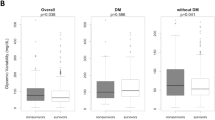Abstract
Hyperglycaemia caused by stress and inflammation is common during critical illness. We hypothesised that a latent glucose metabolism disturbance contributes to development of hyperglycaemia and that those patients have increased risk for diabetes. We included patients with sepsis, acute coronary syndrome and acute heart failure with no history of impaired glucose metabolism and divided them in the hyperglycaemia group (glucose ≥ 7.8 mmol/l) and normoglycaemia group. Patients were followed for 5 years. Follow-up was completed for 115 patients in the normoglycaemia group, of which 4 (3.5%) developed type 2 diabetes. In the hyperglycaemia group 51 patients finished follow-up and 8 (15.7%) developed type 2 diabetes. Relative risk in 5-year period for patients with hyperglycaemia was 4.51 for development of type 2 diabetes. Patients with hyperglycaemia during critical illness who are not diagnosed with diabetes before or during the hospitalisation should be considered a population at increased risk for developing diabetes.
Similar content being viewed by others
References
Benfield T, Jensen JS, Nordestgaard BG (2007) Influence of diabetes and hyperglycaemia on infectious disease hospitalisation and outcome. Diabetologia 50:549–554
Christiansen C, Toft P, Jorgensen HS et al (2004) Hyperglycaemia and mortality in critically ill patients. A prospective study. Intensive Care Med 30:1685–1688
van den Berghe G, Wouters P, Weekers F et al (2001) Intensive insulin therapy in the critically ill patients. N Engl J Med 345:1359–1367
Malmberg K, Norhammar A, Wedel H et al (1999) Glycometabolic state at admission: important risk marker of mortality in conventionally treated patients with diabetes mellitus and acute myocardial infarction: long-term results from the Diabetes and Insulin-Glucose Infusion in Acute Myocardial Infarction (DIGAMI) study. Circulation 99:2626–2632
Van den Berghe G (2002) Neuroendocrine pathobiology of chronic critical illness. Crit Care Clin 18:509–528
Langouche L, Van den Berghe G (2006) The dynamic neuroendocrine response to critical illness. Endocrinol Metab Clin North Am 35:777–791, ix
McCowen KC, Malhotra A, Bistrian BR (2001) Stress-induced hyperglycemia. Crit Care Clin 17:107–124
Grimble RF (2002) Inflammatory status and insulin resistance. Curr Opin Clin Nutr Metab Care 5:551–559
Marette A (2002) Mediators of cytokine-induced insulin resistance in obesity and other inflammatory settings. Curr Opin Clin Nutr Metab Care 5:377–383
Marik PE, Raghavan M (2004) Stress-hyperglycemia, insulin and immunomodulation in sepsis. Intensive Care Med 30:748–756
Aljada A, Ghanim H, Assian E et al (2002) Tumor necrosis factor-alpha inhibits insulin-induced increase in endothelial nitric oxide synthase and reduces insulin receptor content and phosphorylation in human aortic endothelial cells. Metabolism 51:487–491
Mizock BA (2001) Alterations in fuel metabolism in critical illness: hyperglycaemia. Best Pract Res Clin Endocrinol Metab 15:533–551
Clowes GH Jr, Martin H, Walji S et al (1978) Blood insulin responses to blood glucose levels in high output sepsis and septic shock. Am J Surg 135:577–583
Dahn MS, Jacobs LA, Smith S et al (1985) The relationship of insulin production to glucose metabolism in severe sepsis. Arch Surg 120:166–172
Mehta VK, Hao W, Brooks-Worrell BM et al (1994) Low-dose interleukin 1 and tumor necrosis factor individually stimulate insulin release but in combination cause suppression. Eur J Endocrinol 130:208–214
Metso AJ, Murros K (2007) Hyperglycaemia and the outcome of stroke. Brain 130:e85 (author reply e86)
Cubbon RM, Rajwani A, Abbas A et al (2007) Hyperglycaemia, in relation to sex, and mortality after acute coronary syndrome. Eur J Cardiovasc Prev Rehabil 14:666–671
American Diabetes Association (2008) Diagnosis and classification of diabetes mellitus. Diabetes Care 31(Suppl 1):S55–S60
Levy MM, Fink MP, Marshall JC et al (2003) 2001 SCCM/ESICM/ACCP/ATS/SIS international sepsis definitions conference. Intensive Care Med 29:530–538
Pollack CV Jr, Braunwald E (2008) 2007 update to the ACC/AHA guidelines for the management of patients with unstable angina and non-ST-segment elevation myocardial infarction: implications for emergency department practice. Ann Emerg Med 51:591–606
Braunwald E, Antman EM, Beasley JW et al (2000) ACC/AHA guidelines for the management of patients with unstable angina and non-ST-segment elevation myocardial infarction. A report of the American College of Cardiology/American Heart Association Task Force on Practice Guidelines (Committee on the Management of Patients With Unstable Angina). J Am Coll Cardiol 36:970–1062
Goran KP (2007) The consensus is clearly needed for the definition of stress hyperglycaemia in acute myocardial infarction. Eur Heart J 28:2042 (author reply 2042–2043)
Deedwania P, Kosiborod M, Barrett E et al (2008) Hyperglycemia and acute coronary syndrome: a scientific statement from the American Heart Association Diabetes Committee of the Council on Nutrition, Physical Activity, and Metabolism. Circulation 117:1610–1619
Inzucchi SE, Rosenstock J (2005) Counterpoint: inpatient glucose management: a premature call to arms? Diabetes Care 28:976–979
Bryer-Ash M, Garber AJ (2005) Point: inpatient glucose management: the emperor finally has clothes. Diabetes Care 28:973–975
Garber AJ, Moghissi ES, Bransome ED Jr et al (2004) American College of Endocrinology position statement on inpatient diabetes and metabolic control. Endocr Pract 10(Suppl 2):4–9
Kadowaki T, Yamauchi T, Kubota N et al (2006) Adiponectin and adiponectin receptors in insulin resistance, diabetes, and the metabolic syndrome. J Clin Invest 116:1784–1792
Author information
Authors and Affiliations
Corresponding author
Rights and permissions
About this article
Cite this article
Gornik, I., Vujaklija, A., Lukić, E. et al. Hyperglycaemia in critical illness is a risk factor for later development of type II diabetes mellitus. Acta Diabetol 47 (Suppl 1), 29–33 (2010). https://doi.org/10.1007/s00592-009-0115-6
Received:
Accepted:
Published:
Issue Date:
DOI: https://doi.org/10.1007/s00592-009-0115-6




